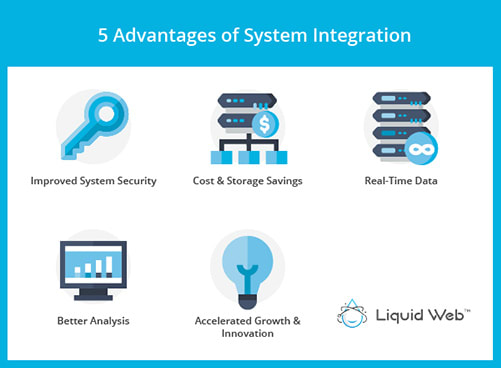
System integration has become significantly more important with the increased adoption of automation technologies, bringing an inherent need to streamline processes for successful management. Businesses need effective technological integration between different systems to simplify workflows and boost efficiency.
In addition to improving efficiency, integrated systems reduce costs, delivering a better return on investment regardless of size or sector.
But what is a system integration exactly, and how do you add this offering to your managed services business?
What is System Integration?
System integration is the act of taking many disparate systems and workflows and bringing them together into a single system that operates more effectively. For example, a system integration might combine software, workflows, networks, and even hardware to improve efficiency and effectiveness throughout an organization.
From one team in a larger business to an integration that touches every part of an enterprise, system integration is about bringing sub-systems together in a way that positively impacts the business.

5 Advantages of System Integration
At its core, every business is a collection of processes and procedures. Data collected from customers and the market move the business forward, ideally in the direction of growth and prosperity.
Imagine a business where those processes and procedures do not work in concert. Imagine an environment where customer information and data do not reach those who need it to succeed.
System integration ensures that processes, procedures, and data are helping the business move forward.
Below are some organizational advantages of system integration:
- Improved System Security: Integrated systems help IT teams and business leaders keep an eye on what data is visible by which individuals or groups. An application that is not properly integrated must be managed and maintained independently, opening the door to a data breach or theft.
- Cost and Storage Savings: Integrated systems remove redundancy in applications and data. For example, instead of storing the same business information within multiple places and multiple systems, an integrated environment means a single instance of data can be accessed by different applications, all from the same place.
- Real-Time Data: With integrated systems, data can be updated in real-time instead of only after someone manually uploads or updates it. A database that connects to all applications can ingest information constantly.
- Better Analysis: Integrated systems also solve the age-old problem of one hand not knowing what the other is doing. Integration means that data and insights can be shared across applications, departments, and teams.
- Accelerated Growth and Innovation: Growth and innovation accelerate due to improved efficiency and effectiveness. Fewer technical or process roadblocks benefit the business as a whole.
What are the System Integration Types?
There are many different ways to integrate systems within a business. For example, bringing different types of software together via API is different than connecting a network of servers in different locations, yet both are examples of integrations.
Most system integrations fall into one of the following three categories:
1. Vertical Integration:
Vertical integration can be thought of as top-to-bottom or start-to-finish. Vertical integration means bringing together tools that work in concert from the beginning of a process until the completion of that process.
For example, vertical integration in accounting would include integrating the systems that create invoices, receive payments, issue accounts payable, run payroll, and reconcile accounts.
A vertical integration creates efficiency by making a process run smoothly with fewer friction points between the start and finish of that process. For a managed service provider (MSP), vertical integration might include helping a client string together different types of software and hardware. This can make an entire set of workflows be completed without interruption.
2. Horizontal Integration
By contrast, horizontal system integration can be thought of as left-to-right or across. In horizontal system integration, tools integrate to streamline or improve a process across a number of different departments or teams.
For example, the sales team, the marketing team, and the IT team do not need their own time-and-attendance tracking system. Therefore, utilizing the same applications and workflows across each team and then feeding the information to human resources (HR) streamlines the workflow. The HR team doesn’t have to use a different tool when logging hours worked for employees on different teams.
Horizontal system integration creates operational efficiency and lowers software license and maintenance costs that would accompany multiple different tools. Horizontal integrations can also include leveraging a VMware Private Cloud for other divisions or integrating a new inventory system into different warehouse locations.
3. Star Integration
A star integration is less common and typically born out of an inability to service horizontal or vertical integration. A star integration connects different systems independently to one central system.
The key to this type of integration is that the central point is responsible for passing data or activity to other points in the system as needed. As such, the center of the integration is of critical importance to keep the entire system running.
Each part of a star integration happens independent of the other points and in isolation. For example, IT or engineering teams testing different tools or code can benefit from this type of integration.
Additionally, businesses with multiple locations or business units that operate independently of each other, but all roll up to headquarters, would benefit from a star integration.
Delivering System Integrations for Your MSP Clients
With effectively integrated systems, your business will see improved efficiency. In addition, alignment between data, processes, and workflows removes significant aggravation and headaches for everyone involved.
As a managed service provider, your role in helping clients integrate systems is crucial. Your technical understanding of the what and the how of integration can open many doors for your business.
Additionally, horizontal and vertical scaling of applications and processes can uncover additional opportunities for you. Understanding which types of integrations would most benefit your clients starts with understanding their needs, their goals, and the resources available.
Our team at Liquid Web has worked with managed service providers for more than two decades to help deliver powerful system integrations for their business clients. If your managed service business could use a partner in delivering the most powerful possible integrations for your clients, let’s talk. Contact us now to explore how a partnership with Liquid Web can make system integrations an even bigger part of your business.
[ad_2]
Source link







